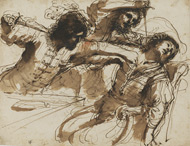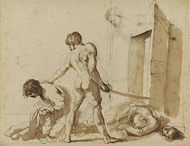 |

 |
 |
The Assassination of Amnon at the Feast of Absalom, 1628
Courtauld Institute of Art Gallery, London
|
 |
 |
|
 |
|
Giovanni Francesco Barbieri (1591–1666), nicknamed Guercino ("squinter") after a childhood incident that left him cross-eyed, was an Italian draftsman and painter renowned for his innovative compositions and psychological insight. This exhibition, a collaboration between the Getty Museum and the Courtauld Institute of Art Gallery in London, explores the distinctive qualities of Guercino's draftsmanship.
In Guercino's drawings we can almost feel the artist's pen scratching the paper. Guercino's favorite medium was a goose-feather pen dipped in ink that allowed him to quickly record his ideas on paper. Touches of wash, areas of diagonal lines, and blurring effects of pentimenti (minor changes) heighten the sense of drama and spontaneity.
The drawing above depicts a story from the Old Testament in which Absalom brings in assassins to kill his half brother, Amnon, for having raped their sister, Tamar. The artist's fleeting lines emphasize the drama and unexpectedness of the attack. Lines surrounding Amnon's head reflect a position for his right arm that the artist abandoned.
|
 |

 |
 |
The Martyrdom of Saints John and Paul, 1630–32
Courtauld Institute of Art Gallery, London
|
 |
 |
|
|
 |
When considering a subject for a painting, Guercino imagined the scene from every conceivable angle. Other artists drew numerous tiny sketches on a single sheet, but Guercino worked up a whole variety of solutions on a large scale. He often then used "close-up" studies to examine the relationships between characters and to explore their facial expressions.
This drawing of the execution of Roman officers John and Paul for their Christian faith is one of several studies that Guercino made in preparation for an altarpiece. The decapitated body of one of the brothers lies on the ground, while the other brother other kneels. The executioner is seen from behind with his face hidden from the viewer.
|
 |
|
Guercino was particularly sensitive to the effects of light and shade. He often chose the medium that best reflected the texture of the subject he was drawing, using wiry pen lines for a moustache or thick strokes of brown wash for wet hair. Such effects imbue his drawings with a keen realism.
This large sheet shows Guercino's skill in drawing from life. He depicted the youth's pose, which is full of complex angles and spatial challenges, almost entirely through shadow using black chalk dipped in gum. In his youth, Guercino ran a life-drawing academy.
|
 |
|
Like many of Guercino's outdoor scenes, this imaginary view of a port is dominated by the stark white of the paper, which creates the effect of strong sunlight.
To emphasize the sense of calmness, Guercino balanced forms and masses, as in the fort's tower and the mast of the docked ship. He added boats, conversing figures, and a fluttering flag to enliven his scene.
|
 |
 |

 |
 |
A Child Seen from Behind, Standing between His Mother's Knees, about 1625
Courtauld Institute of Art Gallery, London
|
 |
 |
|
Guercino had great sympathy for a variety of characters and human situations. His drawings of daily life seem to have been made purely for the amusement of the artist and his friends, and they show a gentle sense of humor and a fond appreciation for everyday life.
Held by the arm, an infant stands between his mother's legs, probably preparing to nurse. Guercino used various techniques to create a convincingly three-dimensional scene. For example, he produced subtle shadows across areas—such as the side of the child's body—by delicately spreading grains of chalk with a blunt stylus or his finger.
|
 |
|
In caricatures such as this one, Guercino lampooned his subjects by exaggerating their features. To create a comic composition, the artist heightened differences in their noses and chins. The tradition of caricature in profile can be traced back to Leonardo da Vinci. Like Leonardo, Guercino was an avid observer of human temperament.
This exhibition is located at the Getty Center, Museum, East Pavilion.
|
 |







